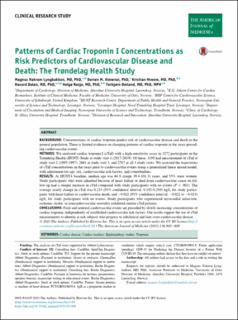| dc.contributor.author | Lyngbakken, Magnus Nakrem | |
| dc.contributor.author | Kimenai, Dorien M. | |
| dc.contributor.author | Hveem, Kristian | |
| dc.contributor.author | Dalen, Håvard | |
| dc.contributor.author | Røsjø, Helge Rørvik | |
| dc.contributor.author | Omland, Torbjørn | |
| dc.date.accessioned | 2024-01-17T09:16:54Z | |
| dc.date.available | 2024-01-17T09:16:54Z | |
| dc.date.created | 2023-08-23T10:55:20Z | |
| dc.date.issued | 2023 | |
| dc.identifier.citation | American Journal of Medicine. 2023, 136 (9), 902-909.e4. | en_US |
| dc.identifier.issn | 0002-9343 | |
| dc.identifier.uri | https://hdl.handle.net/11250/3112050 | |
| dc.description.abstract | Background
Concentrations of cardiac troponin predict risk of cardiovascular disease and death in the general population. There is limited evidence on changing patterns of cardiac troponin in the years preceding cardiovascular events.
Methods
We analyzed cardiac troponin I (cTnI) with a high-sensitivity assay in 3272 participants in the Trøndelag Health (HUNT) Study at study visit 4 (2017-2019). Of these, 3198 had measurement of cTnI at study visit 2 (1995-1997), 2661 at study visit 3, and 2587 at all 3 study visits. We assessed the trajectories of cTnI concentrations in the years prior to cardiovascular events using a generalized linear mixed model, with adjustment for age, sex, cardiovascular risk factors, and comorbidities.
Results
At HUNT4 baseline, median age was 64.8 (range 39.4-101.3) years, and 55% were women. Study participants who were admitted because of heart failure or died from cardiovascular cause on follow-up had a steeper increase in cTnI compared with study participants with no events (P < .001). The average yearly change in cTnI was 0.235 (95% confidence interval, 0.192-0.289) ng/L for study participants with heart failure or cardiovascular death, and −0.022 (95% confidence interval, −0.022 to −0.023) ng/L for study participants with no events. Study participants who experienced myocardial infarction, ischemic stroke, or noncardiovascular mortality exhibited similar cTnI patterns.
Conclusions
Fatal and nonfatal cardiovascular events are preceded by slowly increasing concentrations of cardiac troponin, independently of established cardiovascular risk factors. Our results support the use of cTnI measurements to identify at-risk subjects who progress to subclinical and later overt cardiovascular disease. | en_US |
| dc.language.iso | eng | en_US |
| dc.publisher | Elsevier | en_US |
| dc.rights | Navngivelse 4.0 Internasjonal | * |
| dc.rights.uri | http://creativecommons.org/licenses/by/4.0/deed.no | * |
| dc.title | Patterns of Cardiac Troponin I Concentrations as Risk Predictors of Cardiovascular Disease and Death: The Trøndelag Health Study | en_US |
| dc.title.alternative | Patterns of Cardiac Troponin I Concentrations as Risk Predictors of Cardiovascular Disease and Death: The Trøndelag Health Study | en_US |
| dc.type | Peer reviewed | en_US |
| dc.type | Journal article | en_US |
| dc.description.version | publishedVersion | en_US |
| dc.source.pagenumber | 902-909.e4 | en_US |
| dc.source.volume | 136 | en_US |
| dc.source.journal | American Journal of Medicine | en_US |
| dc.source.issue | 9 | en_US |
| dc.identifier.doi | 10.1016/j.amjmed.2023.05.009 | |
| dc.identifier.cristin | 2168948 | |
| cristin.ispublished | true | |
| cristin.fulltext | original | |
| cristin.qualitycode | 2 | |

